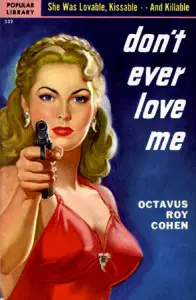 Politically correct or not, I love the artwork on old paperbacks, magazine covers, and dust jackets depicting barely clad babes. I go as far as to collect them. And I find I’m not alone, by a long shot. I belong to flickr, the website for sharing photos. But besides pictures, there’s an underground section filled with vintage illustrations of all types, including crime fiction novels and lurid sci fi magazines. And we that belong to this clandestine section, revel in each other’s uploads filled with the panorama of dames engaged in various activities, none that would pass the vice squad standards for decency.
Politically correct or not, I love the artwork on old paperbacks, magazine covers, and dust jackets depicting barely clad babes. I go as far as to collect them. And I find I’m not alone, by a long shot. I belong to flickr, the website for sharing photos. But besides pictures, there’s an underground section filled with vintage illustrations of all types, including crime fiction novels and lurid sci fi magazines. And we that belong to this clandestine section, revel in each other’s uploads filled with the panorama of dames engaged in various activities, none that would pass the vice squad standards for decency.
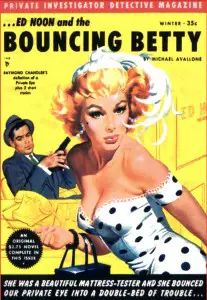
I have an uploaded set of illustrations with all sorts of pulp vixens, as I’ve always labeled them. There is the oversexed vixen, the deadly doll, the dame in distress, the sexy ‘sisters’, and the streetwalkers and call girls.
The oversexed vixen is shown in various ways on the covers–but the titles really tell the story. “One Night With Diane” “Bedroom Eyes,” Fast Loose and Lovely,” “A Woman Must Love,” and an all time favorite, “Bouncing Betty” Now, now, get your mind out of the gutter–she’s a mattress tester!
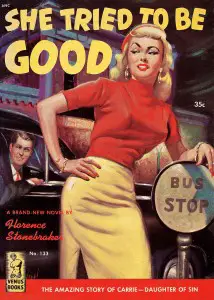 Some girls TRY not to indulge in such behavior but fail. “Virtuous Girl,” “She Couldn’t Be Good,” “When She Was Bad,” and She Tried To Be Good.” And, oh, so many more. Each cover has impossibly built bodies–even Barbie can’t compete with the measurements some of these babes have. The waists are barely visible, the chests unavoidable. Unnaturally pointed, some could poke your eyes out. All are knockouts in every sense.
Some girls TRY not to indulge in such behavior but fail. “Virtuous Girl,” “She Couldn’t Be Good,” “When She Was Bad,” and She Tried To Be Good.” And, oh, so many more. Each cover has impossibly built bodies–even Barbie can’t compete with the measurements some of these babes have. The waists are barely visible, the chests unavoidable. Unnaturally pointed, some could poke your eyes out. All are knockouts in every sense.
The dangerous dolls are no exception in looks, but they have a special accessory, a gun. These women are not to be taken lightly, if taken at all–many men try and fail: “Call Me Deadly,” “Hard-Boiled Blonde,” “Shady Lady,” “Miss Dynamite,” and “Dames Don’t Care.” Usually, this type of vixen are on crime novels, mostly paperbacks. And, unlike the trashier titles, many have been published in hardcover first, with no hint of a sexual aspect. That’s because most covers have absolutely nothing to do with the interior plot. The paperback industry needed to sell books. And who are reading crime novels? Men. And what sells? Sex. So, put a lovely lady on the cover and lure unsuspecting males into grabbing a copy in a drugstore. Paperbacks began their reign in the 40s, got going strong in the 50s, and never declined. But the artists by the 60s had pushed the envelope on what could be shown, and almost completely nude women graced even well respected writers books, like John D. MacDonald.
“Don’t Ever Love Me” is a perfect example of bait and switch. Roy Octavius Cohen didn’t write sexy mysteries, at least not as created by artist Rudolph Belarski. But what a cover! The reader looks directly into the barrel of the blonde’s gun.
 On the other side of the coin are the dames in distress, those ladies whose lives and outfits are hanging by a thread. Some titles weren’t indicative of the artwork: “The Yellow Overcoat” manages to have a beautiful blonde shrinking away in terror as a bad guy approaches. On the cover of “The Dogs Do Bark” this blonde is clad in a way off the shoulder peasant blouse, her eyes widened in fear, with the lines–‘Her love was sinful-and deadly!’ Now I’ve read the author, and there are no sinfulness going on in his books! Other dames in distress covers have titles to match: “Lady in Peril,” “Don’t Look Behind You,” and “I Wake Up Screaming.” There is no guarantee that there’s a dame in the book, let alone in distress!
On the other side of the coin are the dames in distress, those ladies whose lives and outfits are hanging by a thread. Some titles weren’t indicative of the artwork: “The Yellow Overcoat” manages to have a beautiful blonde shrinking away in terror as a bad guy approaches. On the cover of “The Dogs Do Bark” this blonde is clad in a way off the shoulder peasant blouse, her eyes widened in fear, with the lines–‘Her love was sinful-and deadly!’ Now I’ve read the author, and there are no sinfulness going on in his books! Other dames in distress covers have titles to match: “Lady in Peril,” “Don’t Look Behind You,” and “I Wake Up Screaming.” There is no guarantee that there’s a dame in the book, let alone in distress!
The gay population, at least in pulp vixen land, were not left out. Yet–the books are still appealing to men. Multiple scantily clad dolls are on these covers with titles that hint, but never really come right out and say what their content is about. “Warped Women” has a real photo of two women, one whipping the other. ‘Helpless wretches, stripped by strong emotions of all restraint and decency–would they ever again know real love?’ Not exactly a pretty vision of gay life, but one that may feed into a male’s fantasy of such. “Sinful Sisters” doesn’t hold back-two women in various states of undress adorn the cover, one obviously still in the throes of passion. “The Queer Sisters” comes right out and proclaims it–with the added–‘Twisted love and hateful passion in a suspenseful setting.’ Notice how the love between two women is always seen as sick? And the most blatant–“Strange Sisters” states-‘She dared enter a lesbian world.” The lady in question is hanging off a guy’s arm while giving the eye to smoking blonde on the side.
are still appealing to men. Multiple scantily clad dolls are on these covers with titles that hint, but never really come right out and say what their content is about. “Warped Women” has a real photo of two women, one whipping the other. ‘Helpless wretches, stripped by strong emotions of all restraint and decency–would they ever again know real love?’ Not exactly a pretty vision of gay life, but one that may feed into a male’s fantasy of such. “Sinful Sisters” doesn’t hold back-two women in various states of undress adorn the cover, one obviously still in the throes of passion. “The Queer Sisters” comes right out and proclaims it–with the added–‘Twisted love and hateful passion in a suspenseful setting.’ Notice how the love between two women is always seen as sick? And the most blatant–“Strange Sisters” states-‘She dared enter a lesbian world.” The lady in question is hanging off a guy’s arm while giving the eye to smoking blonde on the side.
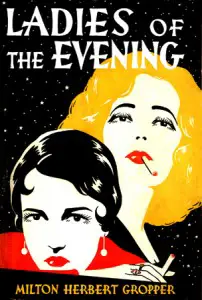 Ah, those ladies who get paid. No need to pussyfoot around this area. Vixens who are in the market for sex get the royal treatment. “What’s In It For Me,” “Make Me An Offer,” “No Bed of Her Own,” “Murder of a Wanton,” and “Kept Woman” say it all. The artwork ranges from tastefully rendered to half undressed.
Ah, those ladies who get paid. No need to pussyfoot around this area. Vixens who are in the market for sex get the royal treatment. “What’s In It For Me,” “Make Me An Offer,” “No Bed of Her Own,” “Murder of a Wanton,” and “Kept Woman” say it all. The artwork ranges from tastefully rendered to half undressed.
Even straight novels and usually staid stories were not immune from the pulp vixen. Agatha Christie among plenty of other authors’ work was deceptively sold with the same pointy body parts seen on less distinguished works. Classics weren’t left out, westerns were chock full of pulp vixens, in boots, of course, and then there were the pulp magazines. 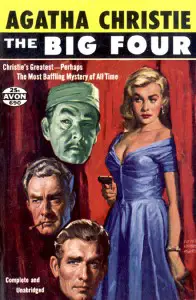
The detective and fantasy pulps came the closest to actual porn. However, they were always able to cover the most offensive bits, either by ripped clothing, well placed ropes, or my favorite, steam. One cannot describe the luridness, one must experience it!
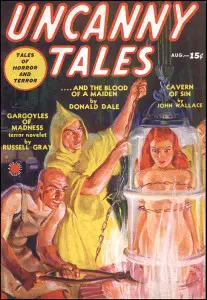 There were numerous magazines to choose from: Astonishing Stories; Amazing Stories; Weird Tales; Fantastic Adventures; Doctor Death; Shock; and Terror Tales are but a few of the sci fi or fantasy.
There were numerous magazines to choose from: Astonishing Stories; Amazing Stories; Weird Tales; Fantastic Adventures; Doctor Death; Shock; and Terror Tales are but a few of the sci fi or fantasy.
Detective pulp could be a combination of mystery and fantasy. Some detective mags were: The Argosy; Daring Detective; Dime Detective; Black Mask; Gun Molls; Detective Fiction Weekly; and more than I can count.
Of course the best known and most collectible must be Spicy Mystery Stories and Spicy Detective–their covers were over the top in dramatics with no clothing. Sets of cards were sold and perhaps still are, of some of their best covers.
With the pulp magazine, creepy isn’t left out. While the vixen may be unclad and in perilous positions, the villains range from accepted stereotypes of the time–scary Japanese; Asians committing torture; Arabs kidnapping women for slavery; and unearthly creatures–skeletons; wild beasts; alien abductors; mad scientists; and demonic beings.
in perilous positions, the villains range from accepted stereotypes of the time–scary Japanese; Asians committing torture; Arabs kidnapping women for slavery; and unearthly creatures–skeletons; wild beasts; alien abductors; mad scientists; and demonic beings.
What can be seen as a troubling aspect is the way some artists depicted women–in chains, tied down, hanging from ropes, in various bondage scenes. I see the possible problems with these images, but personally, I find them campy, fun, not to be taken seriously. I mean, how many women are reduced to a teeny thing and then enclosed in a bell jar or encased in giant ice cubes in real life? And it’s not just the ladies who are all tied up-the heros have just as tough a time. There are plenty of covers with vixens fighting back, holding guns, wielding knives, and generally kicking butt.
 So who were responsible for the outlandish works of art? This is where I fall down on the job, because I don’t collect the books and magazines with the idea of identifying and separating them by artist. But, although I may not, luckily there are plenty of collectors who provide all the pertinent info. Books dedicated to the pulp vixen and their creators are available as well.
So who were responsible for the outlandish works of art? This is where I fall down on the job, because I don’t collect the books and magazines with the idea of identifying and separating them by artist. But, although I may not, luckily there are plenty of collectors who provide all the pertinent info. Books dedicated to the pulp vixen and their creators are available as well.
If anyone is interesting in perusing my and other’s flickr streams, here are the links:
http://www.flickr.com/photos/picture-perfect-designs-jewelry/sets/72157612722604560/
http://www.flickr.com/photos/micksidge/
http://www.flickr.com/photos/42080330@N03/
http://www.flickr.com/photos/16186640@N05/
As well as ABE’s fab look at pulp vixens.
http://www.abebooks.com/books/deadly-dame-vixen-blonde-bombshell/women-pulp.shtml
